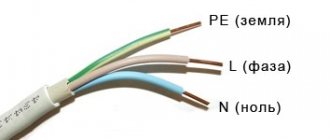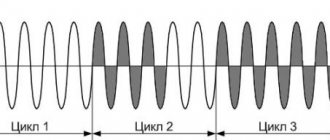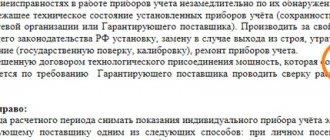This table provides information on the monthly electricity consumption of electrical household appliances.
| Electricity consumer | Power, kWt | Qty | Average operating time | electricity consumption (kWh) |
| Fridge | 1 | 1 | 2 hours a day (including pauses) | 60 |
| Kettle | 2 | 1 | 0.3 hours a day | 18 |
| TV | 0,1 | 1 | 5 hours a day | 12 |
| Washing machine | 1,5 | 1 | 3 hours a week | 20 |
| Iron | 1,2 | 1 | 1 hour per week | 6 |
| Microwave | 1,2 | 1 | 15 min.day | 9 |
| Vacuum cleaner | 1,2 | 1 | 30 min. week | 3 |
| Lighting lamps | 0,06 | 10 | 3 hours a day | 54 |
| Convector (heater) | 1 | 1 | 4 hours a day (including pauses) | 120 |
| Water supply pump | 1,5 | 1 | with an average switching on of 40 days for 10 seconds. | 5 |
| Computer | 0,16 | 1 | 1 hour | 5 |
| TOTAL | 312 |
These data are based on the residence of an average family of 3 people. Also, please note that the number of appliances listed in the house is often used more. Sometimes, in a country house there are 2-3 refrigerators, dishwashers are used, there may be more than 1 heater, an electric stove, etc. not to mention houses that are heated entirely by electricity. We also have bathhouses, gazebos, watering pumps, site lighting and much more. So, once again, when you pay for the consumed electricity per month at 60 - 100 kWh, doesn’t this mean that you either use only a refrigerator, or use solar panels and wind energy generators.
How much electricity do household appliances consume?
Today, energy costs make up a significant part of the family budget. To intelligently approach the problem of energy consumption and associated costs, you need to know how much electricity different household appliances consume and how to calculate the cost of these costs.
How to calculate the electricity consumption of household appliances
Each device has a sticker on the back or side with its characteristics. The power of the device is indicated in watts (W or W). If you do not find a sticker with designations, the characteristics can be found in the instructions. To calculate electricity consumption, you need to multiply the power of the device by the duration of its operation in hours.
For example, a washing machine runs for an hour and a half at a time, and its power is 1,000 W. Then the amount of energy consumed per wash will be 1,000 × 1.5 = 1,500 Wh. Dividing this value by 1,000 will convert Watts to kW. The result is 1.5 kWh. Next you need to multiply this value by the number of washes per week or month. Let's take 3 washes per week, or 12 per month. This means that the washing machine uses 18 kWh over the course of a month. To calculate the approximate cost, multiply the amount of energy consumed by the tariff. The cost of 1 kWh is indicated on the receipt.
How much electricity do household appliances consume?
The total power consumed by the computer will be the sum of the powers of the power supply and monitor. The power supply requires from 350 to 550 W, depending on the work the device performs. If you chat on social networks, energy consumption will be minimal. While working in complex graphics editors like Adobe Illustrator will make the computer burn more energy. The power required by a monitor depends on its size: a 19-inch monitor consumes about 60 W, a 24-inch monitor consumes 80 W. In total, the average will be about 500 Wh, or 0.5 kWh.
Since the laptop only uses the power supply, no matter what functions it performs, its power consumption will be lower than that of a desktop computer. On average - from 0.05 to 0.1 kWh.
The energy consumption of a TV directly depends on the size of the screen and the design. Thus, devices with a cathode ray tube require from 60 to 100 W. Liquid crystal models require from 150 to 250 W, plasma models - 300-400 W. If you turn off the TV using the remote control, leaving it plugged in, the device will go into standby mode. A small red light will light up. Energy consumption in this case will be 2–3 W for models with a cathode ray tube and 4–6 W for LCD and plasma TVs.
The refrigerator is perhaps the only appliance that operates 24 hours a day, seven days a week. It must be remembered that depending on the time of year and workload, the same model will require different amounts of energy. In the cold season, the device uses approximately half as much energy as in the heat. A filled device requires less fuel than an empty one.
All refrigerators are divided into energy consumption classes. For models with low energy consumption, the required amount of energy is approximately equal to the volume of the device in liters. For example, a refrigerator with a volume of 240 liters uses 240 kWh per year. On average, this figure ranges from 230 to 460 kWh per year. The exact value for your model can be found in the instructions. To calculate the daily rate, you need to divide the annual consumption by 365. The result is from 0.6 to 1.2 kWh per day.
When you have to pay taking into account the standards if you have an electric meter
In some situations, consumers have to pay according to standards even if they have an electric meter. This is necessary if:
- the metering device is out of order;
- the owner of the premises did not report indicator data to the utility company;
- access to the metering device is not provided to an employee of the energy supply company;
- the meter was damaged intentionally.
If the consumer does not provide the management company with information regarding the meter readings, the amount for the next quarter is calculated based on the average value. After the specified period, if the situation has not changed, payment is calculated according to the norms.
The breakdown of the electric meter must be confirmed by a corresponding report drawn up based on the results of an inspection of the device by a representative of the utility company. The owner must immediately report problems with the operation of the device orally (in person or by telephone) or in writing in order to record the fact of the breakdown.
Important! The electric meter can only be used within the verification period. If the verification is overdue, the meter readings are invalid.
The owner is obliged to monitor the condition of the electric meter and promptly provide the device for verification to specialized organizations that have the appropriate license.
Table of Approximate Energy Use of Electrical Appliances
Have your electricity bills shocked you? Don’t know where these amounts come from? It seems that you don’t do a lot of laundry, and don’t turn on the lights in vain, but the counter inexorably adds up to high numbers. It might be worth finding out how much energy all your appliances actually consume.
Without a doubt, the most kilowatts come from household appliances that you use constantly. How can you find out which devices are more economical and which are not?
To calculate the electricity consumption of a specific device per unit of time, you need to pay attention to the following characteristics:
Directly the power of the device itself: the engine or power supply.
The amount of time the device operates.
Ambient temperature.
Of course, not in all cases the above factors play a significant role. But for some household appliances (for example, a refrigerator), every point is important. The following table of electricity consumption for household appliances will give an idea of the approximate consumption per month.
What is regulated
The procedure for calculating standards for electricity supplied to the population and other issues related to the consumption of this resource are regulated by the following legislative acts:
- Government Decree No. 614, signed in July 2017 and defining the procedure for social rationing of electricity. Read the resolution (the document will open in a new tab).
- Federal Law No. 35-FZ, adopted in March 2003 with amendments in 2022, establishing the general principles of the Russian electric power industry. Read the law.
- Federal Law No. 261-FZ of November 23, 2009, aimed at energy saving and reducing electricity losses. Read the law.
Read more: How to change a kindergarten in the electronic queue for public services
The latest changes in terms of approval of monthly electric energy limits were made in 2013. The standards have increased by 10% compared to those previously in force. This measure is aimed at stimulating citizens to install individual metering devices, since paying by meter forces the consumer to save resources.
HOW MUCH ELECTRICITY DO HOUSEHOLD APPLIANCES CONSUME?
Surely, at some point in your life, some of you have heard from your family that increased electricity bills are entirely your fault. Either you watch a lot of TV, then you sit at the computer for a long time, then you iron a lot or do laundry often. Again, the question of the size of electricity charges may suddenly worry you yourself. Let's try to at least roughly figure out how much electricity household electrical appliances can consume.
By and large, if we count roughly and approximately, everything depends on the power of the power supply and the specific work that the computer is currently performing. With the declared power of the unit ranging from 350 to 550 Watts, it is unlikely to consume all of it even at full load. You can also add a monitor here - from 60 to 100 watts. Thus, the average 450 Watt power supply and 100 Watt monitor consume 550 Watts or 0.55 kW of electricity per hour. Again, these figures are greatly overestimated. For an approximate calculation, you can take almost the maximum value – 0.5 kW/h – we won’t be mistaken. When using a computer 4 hours a day, we get 60 kW/h per month. Accordingly, when used 8 hours a day - 120 kW/h, and so on.
The energy consumption of refrigerators is calculated over 365 days for a 220V/50Hz network. Designed for 100 liters of useful volume per day, it allows you to compare refrigerators of different sizes. Again, the amount of power consumed depends on the volume of the refrigerator and the amount of food stored in it. External conditions also leave their mark, changing depending on the time of year. The technical data sheet for the refrigerator indicates the energy consumption per year. In most cases, this figure ranges from 230 to 450 kW/h. By simple calculations, dividing this figure by 12 months, we get from 20 to 40 kW/h. Again, this number only applies under ideal conditions. In reality, it is unlikely that this value will be achieved.
Calculation procedure
The amount of payment for consumed electricity in the absence of an individual meter is determined by the following formula:
P = L*N*T,
- P – total payment amount;
- L – number of people registered in the apartment;
- N – the limit of the standard approved in the region per person living in a given living space;
- T – the cost of one kilowatt-hour, according to the approved tariff plan.
Additionally, an increasing coefficient is applied, adopted to encourage citizens to install individual metering devices. The increasing factor should not be taken into account only in a situation where the installation of electricity meters is impossible due to the dilapidation of housing or the unsuitability of electrical networks for this.
Electricity consumers in the house
Decree of the Government of the Russian Federation No. 334 “On improving the procedure for technical connection of consumers to electrical networks” dated April 21, 2009 states that a private individual can connect up to 15 kW to his home. Based on this figure, we will make a calculation and see how many kilowatts will be enough for our home. To carry out the calculation, you need to know how much electricity each electrical appliance in the house consumes.
Power table of household electrical appliances
The power table for household electrical appliances shows approximate electricity consumption figures. Energy consumption depends on the power of the devices and the frequency of their use.
| Electrical appliance | Power consumption, W |
| Appliances | |
| Electric kettle | 900-2200 |
| Coffee machine | 1000-1200 |
| Toaster | 700-1500 |
| Dishwasher | 1800–2750 |
| Electric stove | 1900–4500 |
| Microwave | 800–1200 |
| Electric meat grinder | 700–1500 |
| Fridge | 300–800 |
| Radio | 20–50 |
| TV | 70–350 |
| Music Center | 200–500 |
| Computer | 300–600 |
| Oven | 1100–2500 |
| Electric lamp | 10–150 |
| Iron | 700–1700 |
| Air purifier | 50–300 |
| Heaters | 1000–2500 |
| Vacuum cleaner | 500–2100 |
| Boiler | 1100–2000 |
| Instantaneous water heater | 4000–6500 |
| Hairdryer | 500–2100 |
| Washing machine | 1800–2700 |
| Air conditioner | 1400–3100 |
| Fan | 20–200 |
| Power tools | |
| Drill | 500–1800 |
| Hammer | 700–2200 |
| Circular saw | 700–1900 |
| Electric planer | 500– 900 |
| Electric jigsaw | 350– 750 |
| Grinding machine | 900–2200 |
| A circular saw | 850–1600 |
Let's do a little calculation based on the data from the table of power consumption of household electrical appliances. For example, in our house there will be a minimum set of electrical appliances: lighting (150 W), refrigerator (500 W), microwave (1000 W), washing machine (2000 W), TV (200 W), computer (500 W), iron (1200 W), vacuum cleaner (1200 W), dishwasher (2000 W). In total, these devices will consume 8750 W, and given the fact that these devices will almost never be turned on at once, the resulting power can be divided in half.
Allowances
Citizens who live in premises equipped with electric stoves and water heaters rather than gas stoves are entitled to a premium.
The same applies to Russians living in rural areas - they will also receive an additional amount of electricity. The amount of the premium is set at the regional level. The amount of additional volume (using the example of the Leningrad region) is:
- in houses with electric stoves - 50 kW/hour per person;
- for residential buildings not equipped with electric stoves for cooking - 606 kW/hour;
- Payment for energy supply at dachas occurs according to the standards adopted for one person;
- in houses heated by electricity (with installed meters) - an additional 1000 kW/hour.
How many kilowatts do you need to heat a house?
The main consumers of electric current in homes are lighting, cooking, heating and hot water.
During the cold season, it is important to pay attention to the heating of the house. Electric heating in a house can be of several types:
- water (batteries and boiler);
- purely electric (convector, heated floor);
- combined (warm floor, radiators and boiler).
Let's look at electric heating options and energy consumption.
- Heating using a boiler. If you plan to install an electric boiler, then the choice should fall on a three-phase boiler. The boiler system equally divides the electrical load into phases. Manufacturers produce boilers with different capacities. To choose the right one, you can make a simplified calculation by dividing the area of the house by 10. For example, if the house has an area of 120 m2, then for heating you will need a 12 kW boiler. To save on electricity, you need to install a two-tariff mode for using electricity. Then at night the boiler will operate at an economical rate. Also, in addition to the electric boiler, you need to install a buffer tank, which will accumulate warm water at night and distribute it to heating devices during the day.
- Convector heating. As a rule, convectors are installed under windows and connected directly to an outlet. Their number should correspond to the presence of windows in the room. Experts recommend calculating the total amount for the power consumption of all heating devices and equally distributing it across all three phases. For example, the heating of one floor can be connected to the first one. To another phase, the entire second floor. To the third phase, add a kitchen and a bathroom. Today, convectors have improved functions. This way you can set the desired temperature and choose the heating time. To save money, you can set the time and date of operation of the convector. The device has a “multi-tariff” option, which turns on the heater at the required power or at a reduced rate (after 23-00 and before 8-00). Energy calculations for convectors are similar to the boiler in the previous paragraph.
- Heating using underfloor heating. A very convenient heating option, as you can set the desired temperature for each room. It is not recommended to install heated floors in the place where furniture, refrigerators, and bathrooms are installed. Calculations show that a house of 90 m2 with an installed convector and heated floor on one floor consumes from 5.5 to 9 kW of electricity.
What formula is used to determine one-time tax from January 1, 2022?
Electricity spent on general household needs is calculated in two ways:
- According to the readings of the metering devices installed in the apartment building.
- According to generally accepted standards that are established by regional or local authorities.
The first option is often more economical and therefore more profitable for residents. The presence of meters simplifies the calculation process. At the end of the months, the responsible employee takes readings from the common building meter and subtracts from it the kilowatts consumed by each apartment separately. As a result, the number of kilowatts spent on the operation of the elevator, lighting in the entrances and other needs is calculated.
The formula for calculating electricity ONE for each individual apartment is as follows:
(OP – SP) * DP = IO , where:
- OP – general house consumption indicator;
- SP - the amount of electricity consumption for all individual metering devices (this includes apartments without meters);
- DP – the share of the apartment’s area from the total area of all apartments;
- IO is the final indicator of payment for an apartment.
DP is calculated using the formula:
OPK / SP , where:
- OPK – total area of the payer’s apartment;
- SP – the total area of all apartments in an apartment building.
Let's look at an example: There are 100 apartments in an apartment building with the same area of 50 sq.m. Each of them consumed 150 kW per month. The total electricity consumption was 17,000 kW.
Let's do the calculation: (17000 – 15000) * (50/5000) = 20 kW.
One apartment will be charged for 20 kW spent on ODN.
Calculation rates are individual.
Read about the average electricity consumption in an apartment per month here.
How to save energy?
Today there are many options for saving energy. These methods are not at all complicated, but for them to work you need to use them every day. Reducing energy consumption will not only save the family budget, but will also reduce emissions into the environment.
Simple and time-tested saving methods
- Use of energy-saving light bulbs. Such lamps practically do not heat up, so electricity is spent only on lighting. On average, the service life of such lamps is up to 3 years, and this will significantly save costs. Such lamps consume 5 times less electricity, their service life is 10 times longer and pay for themselves in 1 year.
- When using household appliances, it is important to follow the instructions. Let's take the refrigerator for example. It cannot be placed near a stove or radiator, as the device will need to work uninterruptedly to maintain the required temperature. The same applies to the moment when hot food is placed. It is important not to forget to defrost the refrigerator in a timely manner, since ice in the freezer contributes to high energy costs (up to 20%).
- When leaving the room, do not forget to turn off the lights. This advice is the most effective way to save energy.
- Clean light bulbs regularly. At first glance, such advice seems ridiculous. But few people know that dust can block up to 15% of the light. It is important not to forget about the cleanliness of the lampshades. You can use lower wattage lamps.
- Make some minor cosmetic repairs to the room. When choosing wallpaper, you should pay attention to light shades, as they can make the room 80% brighter and more comfortable. We should not forget about the ceiling; it should be made white. This way you will turn on the lights less often.
- Application of heat-reflecting screens. They are made from foil or foam foam. They should be installed behind the battery. Thanks to such screens, the temperature in the room can be raised by several degrees.
- Insulation of the room. It is necessary to insulate the windows or replace them with metal-plastic ones. Up to 30% of heat can be lost through windows. You should hang thick curtains on the windows. If possible, you need to insulate the entrance doors, as well as the walls, ceilings, floors and roofs of the house.
- Purchasing household appliances of class “A”, “A+” and “A++” can save up to 50% of electricity.
- It is not recommended to leave devices in “standby” mode. A person uses any technology for only a few hours during the day. The rest of the time it is in “standby” mode and gradually absorbs electricity. To save money, devices should be turned off from the network.
And so, we already know how many kilowatts are needed for a home. Let's summarize. From what was described above, it follows that if we use electricity sparingly, then we can easily invest in 15 kW, and for a small house this is even enough for heating. Then the whole family will feel comfortable in their cozy nest.











